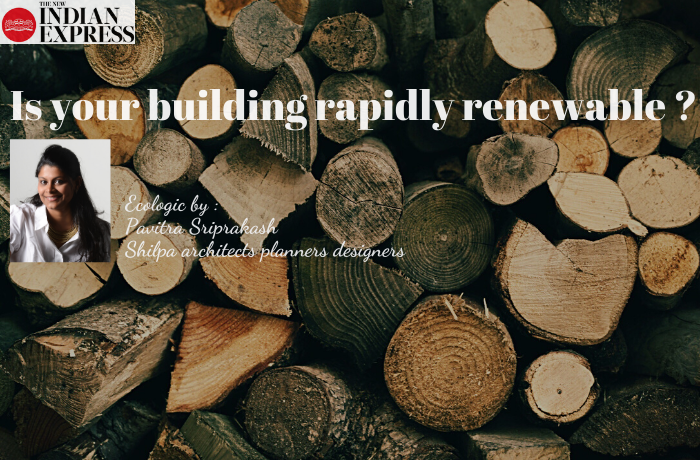19-Feb-2020: Pavitra Sriprakash, Director and Chief Designer at Shilpa Architects Planners Designers writes a weekly column on Sustainability for The New Indian Express titled “ECOLOGIC”. This week she writes about rapidly renewable materials.
Full article below: (Also available at The New Indian Express Website)
Is your building rapidly renewable ?
Love is ‘still’ in the air — in the week following Valentine’s Day, fall in love with renewable material as you commit to renewed vows of love to your friends and family. While renewing your love for people comes in the form of committed promises, nature has her own way of providing renewable options for us, so we don’t deplete resources that cannot be re-grown in a short time frame.
Materials from plants that are typically harvested within a ten-year cycle are termed ‘rapidly renewable’. The goal of using materials with rapidly renewable content is to reduce the use of resources with high environmental value. These materials are usually natural and do not contain any organic compounds or hydrocarbons. They include agricultural by-products which are fibrous, such as bamboo, straw, cork, soy, cotton, sunflowers, hemp, wheat-board and strawboard.
By using materials produced with these quick-to grow plant-based products, the harvesting of forests and other resources that take decades to regenerate can be reduced. Some green building materials are comprised of a composite of rapidly renewable materials and recycled content such as newsprint, cotton, soy-based materials, seed husks, etc. With a variety of wood substitutes flooding our markets, it is easy for us to stick with those from rapidly renewable sources. These can be composite agrifiber boards instead of the typical particle boards and MDF that are widely available. Bagasse board is one of my personal favourites.
Modular furniture for large offices, contributes considerably towards the percentage of the total spend on the interior fit outs and large format offices. The typical usage of plywood or other similar wood substitutes in such large format spaces comes in the form of partitions, panels and the furniture (desks and filing cabinets) themselves. These can easily be substituted with a bagasse board, which uses dried bagasse as it comes out as waste from the sugar factories. The boards are made from the fibrous matter that is further processed to remove the water content in it and compressed into boards in many layers that are glued together with a no-formaldehyde adhesive in order to maintain the eco rating of the product. We often never realise that our furniture if not eco-friendly, will off-gas within a built environment releasing carcinogenic formaldehyde from plywood and particle boards.
When materials and products are selected or specified for projects, it is important to consider several environmental factors, including waste prevention, recyclability, recycled content, resource regeneration and disposal. Rapidly renewable materials don’t contribute to global warming and depletion of natural resources as they are by-products of other industries. These materials improve indoor air quality by cutting out the formaldehyde that standard materials which are not consciously made may contain.
Considering rapidly renewable materials as part of the building’s specs contribute toward the green rating of a building. Innovative usage of these nowadays include some accepted animal sources as well — the consideration being that the animal is not harmed or killed in the process of extracting the product. A widely accepted usage is that of wool as upholstery, carpet or wall panels. Always choose rapidly renewable materials over those that are made by mother earth over centuries — remember if there is a choice for a floor, choose bamboo over marble.



